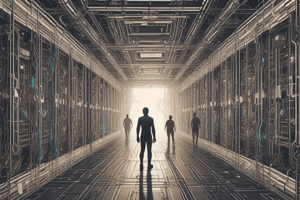Podcast
Questions and Answers
What is a characteristic of top layers of deeper CNNs?
What is a characteristic of top layers of deeper CNNs?
- Predicting IT neural responses at early phases
- Implementing feedforward connections
- Having fewer number of challenge images
- Predicting IT neural responses at late phases (correct)
What is observed in deeper CNNs?
What is observed in deeper CNNs?
- Challenge images with shorter OSTs in the IT cortex
- No change in the number of challenge images
- An increased number of challenge images
- A reduced number of challenge images (correct)
What is a characteristic of challenge images for deeper CNNs?
What is a characteristic of challenge images for deeper CNNs?
- Showing shorter OSTs in the IT cortex
- Having no effect on OSTs in the IT cortex
- Being solved by early phases of IT responses
- Showing even longer OSTs in the IT cortex (correct)
What is CORnet?
What is CORnet?
What is a characteristic of the top layer of CORnet?
What is a characteristic of the top layer of CORnet?
What is a characteristic of pass 1 and pass 2 of CORnet?
What is a characteristic of pass 1 and pass 2 of CORnet?
What is a characteristic of late passes (especially pass 4) of CORnet?
What is a characteristic of late passes (especially pass 4) of CORnet?
What do the results of CORnet suggest?
What do the results of CORnet suggest?
What is a key advantage of deeper CNNs like inception-v3 and ResNet-50 over shallower networks like AlexNet?
What is a key advantage of deeper CNNs like inception-v3 and ResNet-50 over shallower networks like AlexNet?
What is the function of recurrent computations in perception?
What is the function of recurrent computations in perception?
What is the purpose of the study by Tang et al. (2018)?
What is the purpose of the study by Tang et al. (2018)?
What happens when an image is rapidly followed by a spatially overlapping mask?
What happens when an image is rapidly followed by a spatially overlapping mask?
What is the minimum percentage of object visibility required for the visual system to make inferences?
What is the minimum percentage of object visibility required for the visual system to make inferences?
What is the effect of backward masking on object recognition?
What is the effect of backward masking on object recognition?
What is a limitation of standard feed-forward models?
What is a limitation of standard feed-forward models?
What is the result of visual categorization of objects when only partial information is available?
What is the result of visual categorization of objects when only partial information is available?
What was observed in the performance of feed-forward models at limited visibility?
What was observed in the performance of feed-forward models at limited visibility?
What was found to be correlated with the latency of neural response?
What was found to be correlated with the latency of neural response?
What is the difference between masked and unmasked stimuli in the study by Tang et al. (2018)?
What is the difference between masked and unmasked stimuli in the study by Tang et al. (2018)?
What type of networks can perform pattern completion?
What type of networks can perform pattern completion?
What is the relationship between recurrent circuits in the primate brain and deep CNNs?
What is the relationship between recurrent circuits in the primate brain and deep CNNs?
What was added to the AlexNet architecture to improve recognition of partially visible objects?
What was added to the AlexNet architecture to improve recognition of partially visible objects?
What was visualized using stochastic neighborhood embedding?
What was visualized using stochastic neighborhood embedding?
What is a characteristic of attractor networks?
What is a characteristic of attractor networks?
What was observed in the representation of whole objects and partial objects from different categories?
What was observed in the representation of whole objects and partial objects from different categories?
What happened to the representation of partial objects over time in the clusters of whole images?
What happened to the representation of partial objects over time in the clusters of whole images?
What is the typical time frame for the RNNh model's performance and correlation with humans to saturate?
What is the typical time frame for the RNNh model's performance and correlation with humans to saturate?
What is the physiological response to heavily occluded objects, which is consistent with the RNNh model?
What is the physiological response to heavily occluded objects, which is consistent with the RNNh model?
What happened to the RNN model's performance when backward masking was introduced?
What happened to the RNN model's performance when backward masking was introduced?
What is a critical aspect of cognition, as mentioned in the text?
What is a critical aspect of cognition, as mentioned in the text?
What is a limitation of supervised DCNN models in explaining human visual cortex development?
What is a limitation of supervised DCNN models in explaining human visual cortex development?
What is a key difference between human visual input and standard image databases?
What is a key difference between human visual input and standard image databases?
How might humans augment their initial dataset during offline states?
How might humans augment their initial dataset during offline states?
What is a potential role of unsupervised learning in visual cortex development?
What is a potential role of unsupervised learning in visual cortex development?
What is the Local Aggregation (LA) method used for?
What is the Local Aggregation (LA) method used for?
Why are supervised DCNN models not suitable for explaining human visual cortex development?
Why are supervised DCNN models not suitable for explaining human visual cortex development?
What is a difference between human learning and supervised DCNN models?
What is a difference between human learning and supervised DCNN models?
What might be an inductive bias in human learning?
What might be an inductive bias in human learning?
What is the purpose of the optimization process in the embedding space?
What is the purpose of the optimization process in the embedding space?
What is the algorithm used to visualize the embedding space?
What is the algorithm used to visualize the embedding space?
What is the main advantage of contrastive embedding methods?
What is the main advantage of contrastive embedding methods?
What is the dataset used for training the contrastive embedding models?
What is the dataset used for training the contrastive embedding models?
What is the evaluation metric used to assess the transferability of the contrastive embedding models?
What is the evaluation metric used to assess the transferability of the contrastive embedding models?
What is the finding of the study in terms of the contrastive embedding models' performance?
What is the finding of the study in terms of the contrastive embedding models' performance?
What is the architecture used for the contrastive embedding models?
What is the architecture used for the contrastive embedding models?
What is the purpose of applying the MDS algorithm to the 600 images?
What is the purpose of applying the MDS algorithm to the 600 images?
What is the main difference between the ImageNet dataset and real biological data streams?
What is the main difference between the ImageNet dataset and real biological data streams?
What is the name of the dataset that better represents the real infant data stream?
What is the name of the dataset that better represents the real infant data stream?
Which area of the macaque brain did only a subset of unsupervised methods achieve parity with the supervised model in predicting neural responses?
Which area of the macaque brain did only a subset of unsupervised methods achieve parity with the supervised model in predicting neural responses?
What is the main advantage of using deep contrastive learning on first-person video data from children?
What is the main advantage of using deep contrastive learning on first-person video data from children?
Which area of the macaque brain did the best-performing contrastive embedding methods achieve neural prediction parity with supervised models?
Which area of the macaque brain did the best-performing contrastive embedding methods achieve neural prediction parity with supervised models?
What is a characteristic of the ImageNet dataset?
What is a characteristic of the ImageNet dataset?
What is the age range of the children in the SAYCam dataset?
What is the age range of the children in the SAYCam dataset?
What is the duration of the video data in the SAYCam dataset?
What is the duration of the video data in the SAYCam dataset?
What is the purpose of the VIE algorithm?
What is the purpose of the VIE algorithm?
What is achieved by the VIE algorithm?
What is achieved by the VIE algorithm?
What is the main difference between semisupervised learning and purely unsupervised learning?
What is the main difference between semisupervised learning and purely unsupervised learning?
How does the local label propagation (LLP) algorithm work?
How does the local label propagation (LLP) algorithm work?
What is the result of using semisupervised models with 3% supervision?
What is the result of using semisupervised models with 3% supervision?
What is the main advantage of semisupervised models over purely unsupervised models?
What is the main advantage of semisupervised models over purely unsupervised models?
What is the relationship between the performance of semisupervised models and the amount of supervision?
What is the relationship between the performance of semisupervised models and the amount of supervision?
What is the main difference between semisupervised models and supervised models?
What is the main difference between semisupervised models and supervised models?
Flashcards are hidden until you start studying
Study Notes
Deeper CNNs and Ventral Stream
- Deeper CNNs predict IT neural responses at late phases (150-250 ms) more accurately than 'regular-deep' models like AlexNet.
- This suggests that deeper CNNs might be approximating 'unrolled' versions of the recurrent circuits of the ventral stream.
- Deeper CNNs have a reduced number of challenge images, and the remaining challenge images show longer OSTs in the IT cortex.
CORnet Model
- CORnet is a four-layered recurrent neural network model with within-area recurrent connections and shared weights.
- The top layer of CORnet is comparable to IT and has higher IT predictivity for the late phase of IT responses.
- Pass 1 and pass 2 of CORnet are better predictors of early time bins (relevant for control images), while late passes (especially pass 4) are better at predicting late phases of IT responses (crucial for challenge images).
Recurrent Computations
- Recurrent computations act as additional nonlinear transformations of the initial feedforward during core object recognition.
- Deeper CNNs, such as Inception-v3, v4, and ResNet-50, are better models of the behaviorally critical late phase of IT responses due to the introduction of more nonlinear transformations.
Image Completion and RNN
- Recurrent computations enable pattern completion, which allows recognition of poorly visible or occluded objects.
- The visual system can make inferences even when only 10-20% of the object is visible.
Backward Masking
- Backward masking disrupts recognition of partially visible objects by interrupting any additional, presumably recurrent, processing of the image.
Feed-Forward Models and Occlusion
- Standard feed-forward models, such as AlexNet, are not robust to occlusion and their performance declines at limited visibility.
RNN Models
- Recurrent Neural Networks improve recognition of partially visible objects, with the RNNh model demonstrating a significant improvement over the standard AlexNet.
- Attractor networks, such as the Hopfield network, can perform pattern completion.
- The RNNh model's performance and correlation with humans saturate at around 10-20 time steps, consistent with the physiological responses to heavily occluded objects arising at around 200 ms.
Backward Masking and RNN Performance
- Presenting a mask reduces RNN performance, reproducing the effect of backward masking on human performance.
Unsupervised Neural Networks
- Unsupervised models are trained on ImageNet, a dataset of millions of category-labeled images, which is implausible for human infants and nonhuman primates
- Supervised DCNN cannot explain how representations are learned in the brain
- Unsupervised learning algorithms aim to learn representations from natural statistics without high-level labeling
Human Data vs. Standard Image Databases
- Human data is continuous and egocentric, whereas standard image databases are not
- Human input is multimodal, whereas model input is often unimodal
- Humans may rely on different inductive biases, allowing for more data-efficient learning
- Humans may enlarge their initial dataset by using already encountered instances to create new instances during offline states (i.e., imagination, dreaming)
Unsupervised Learning Algorithms
- Local Aggregation (LA) method: optimizes to push the current embedding vector closer to its close neighbors and further from its background neighbors
- Multi-dimensional scaling (MDS) algorithm: used to visualize the embedding space and shows classes with high and low validation accuracy
Contrastive Embedding Methods
- Yield high-performing neural networks
- Outperform other unsupervised methods and even category-supervised models in several tasks, including object position and size estimation
- Equaled or outperformed category-supervised models in several tasks
Comparison to Neural Data from Macaque Cortex
- Unsupervised neural network models were compared to neural data from macaque V1, V4, and IT cortex
- Unsupervised methods were significantly better than the untrained baseline at predicting neural responses in Area V1
- Only a subset of methods achieved parity with the supervised model in predictions of responses in Area V4
- Only the best-performing contrastive embedding methods achieved neural prediction parity with supervised models in Area IT
Deep Contrastive Learning on First-Person Video Data from Children
- ImageNet dataset diverges significantly from real biological data streams
- SAYCam dataset is a better proxy of the real infant data stream, containing head-mounted video camera data from three children
- Contrastive unsupervised learning is robust enough to handle real-world developmental video streams such as SAYCam
- VIE algorithm is an extension of LA to video and achieves state-of-the-art results on a variety of dynamic visual tasks
Partial Supervision
- Semisupervised learning leverages small numbers of labeled datapoints in the context of large amounts of unlabeled data
- Local label propagation (LLP) algorithm embeds datapoints into a compact embedding space and infers pseudolabels of unlabeled images from those of nearby labeled images
- LLP jointly optimizes to predict inferred pseudolabels while maintaining contrastive differentiation between embeddings with different pseudolabels
- Semisupervised models lead to representations that are substantially more behaviorally consistent than purely unsupervised methods, although a gap to supervised models remains
Studying That Suits You
Use AI to generate personalized quizzes and flashcards to suit your learning preferences.




